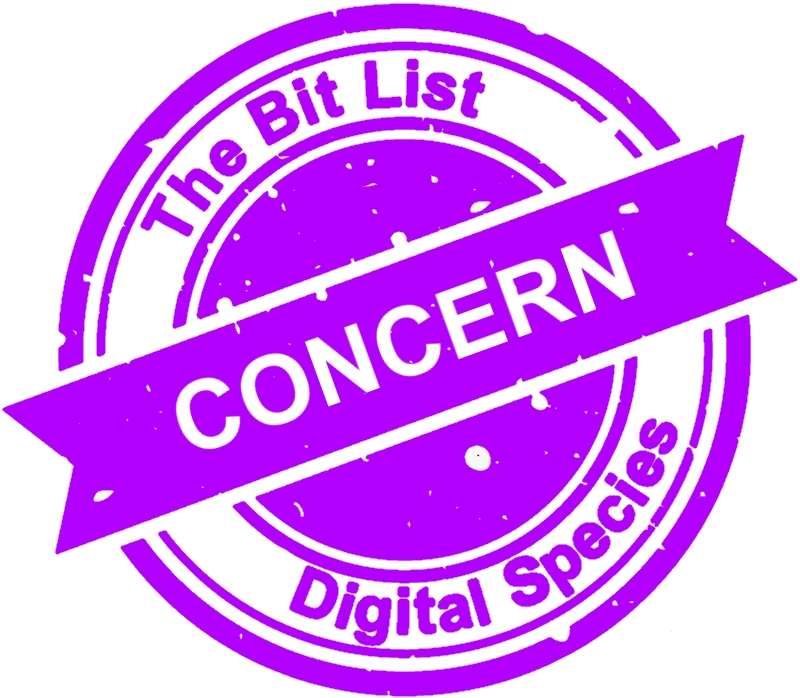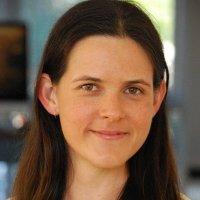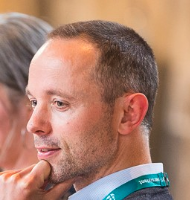DPC
Concern
Digital materials are listed as of Concern when an active member of the digital preservation community has expressed a legitimate concern but the concern has not yet been assessed by the Bit List Council. They will be assessed for inclusion in the subsequent year.
Items of Concern |
||
|
Digital materials are listed as Of Concern when an active member of the digital preservation community has expressed a legitimate concern but the concern has not yet been assessed by the BitList Council. They will be assessed for inclusion in the subsequent year. |
||
|
Action: To be assessed by BitList Council within 12 months Assessment Proposed: November 2023 |
Items of concern: - Webinar recordings on specific platforms; ... (click here to submit a nomination for an at-risk item!) |
|
|
|
||
If I had a time machine: Letter to past-DP-newbie-me
Michelle Lindlar is Digital Preservation Team Leader at Technische Informationsbibliothek (TIB) in Germany.
Dear past self,
You left your IT job a couple of months ago to work in digital preservation. It seemed like a really exciting and good fit given your background and interests. I think you’re still trying to work out the culture shock of working in a public service environment and trying to figure out what digipres is ‘zactly. I thought a few pointers and words of encouragement from future-you-who-has-been-in-the-job-for-a-while would be good.
Digital Music Production MK I.
Thomas Bårdsen is Audio Production Manager at the National Library of Norway
I guess the first digital thing that entered my house growing up, was music. A shiny disc of digital information, read out via laser technology. So futuristic, at the time I think it even changed my hairstyles in a more “pointy” direction. Those discs were just an end product of a whole new direction in music production. The whole music production chain aimed digital. The discs were graded and stamped as if they were jewelry. DDD meaning digital technology were used from start to finish. Music productions have in some ways been born digital for over 35 years. It has also left some strange digital collections behind. In the very early eighties, going digital was a risky and costly piece of business. The previous analog era in music technology, had at least tried to be compatible. The new approach from the industry was that of proprietary systems. Legendary record producer Richard Burgess called the approach of the early digital audio formats a winner takes all play, were larger companies hoped on maximizing profits by squeezing out all competition.
Selecting a Digital Preservation System for the University of St Andrews
"We build our computer (systems) the way we build our cities: over time, without a plan, on top of ruins." - Ellen Ullman
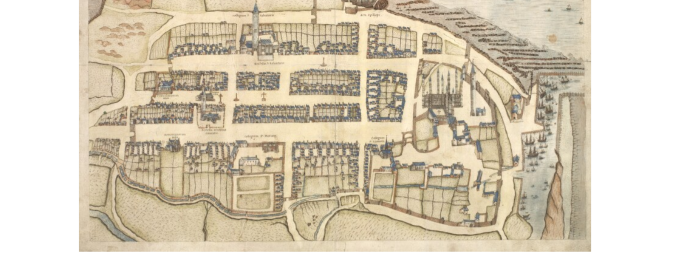
John Geddy’s map of St Andrews, c.1580. National Library of Scotland (MS.20996) http://maps.nls.uk/view/00001427
Thoughts on Fixity Checking in Digital Preservation Systems
Neil Jefferies is Head of Innovation at Bodleian Libraries, University of Oxford
I would like to query the rationale for actually doing periodic fixity checking in isolation. This has bugged me for a bit so I am going to unload.
As far as I can see, the main reasons would be undetected corruption on storage and tampering that doesn’t hijack the chain of custody.
All storage media now have built-in error detection and correction using Reed-Solomon, Hamming or something similar which is generally capable of dealing with small multi-bit errors. In modern environments, this gives unrecoverable read error rates of at worst around 1 in 10^14 and generally several orders of magnitude better – which is around one in 12TB total read. Write errors are less frequent – they do occur but can be detected by device firmware and retried elsewhere on the medium. These are absolute worst case figures and result in *detectable* failure long before we even get to computing fixity. The chance of bit flips occurring in such a pattern as to defeat error correction coding is several orders of magnitude less – it is similar to bit flips resulting in an unchanged MD5 hash. Interestingly, in most cases the mere act of reading data allows devices to detect and correct future errors as the storage medium becomes marginal so there is value in doing that.
Preservation storage workshop at iPres 2017
Read Jaye Weatherburn's account of sessions at iPRES 2017. Jaye, who works at the University of Melbourne, attended iPRES with support from the DPC's Leadership Programme which is generously funded by our Commericial Supporters.
At iPres 2017 (in September | Kyoto, Japan) I attended the Digital Preservation Storage Workshop: Exploring Preservation Storage Criteria and Distributed Digital Preservation.
I was particularly keen to attend this workshop, as in my role at the University of Melbourne I am actively working with the research support community to develop better understanding of what digital preservation storage means and its requirements, as part of our Digital Preservation Project. We have used the most recent version (version 2) of the preservation storage criteria to run a workshop with our archivists, records managers, and IT staff, and have found this list of 58 criteria extremely useful both for increasing knowledge and understanding about preservation storage needs, and for generating discussion about what is required for preservation storage for different digital collections at the university.
The preservation storage criteria were originally developed by Kate Zwaard, Gail Truman, Sibyl Schaefer, Jane Mandelbaum, Nancy McGovern, Steve Knight, and Andrea Goethals, and have been further developed through workshops and presentations at various conferences and meetings during 2016-2017 (iPres conferences, PASIG meetings, the Library of Congress Designing Storage Architectures for Digital Collections 2016 meeting).
Cloudy Culture: Preserving digital culture in the cloud
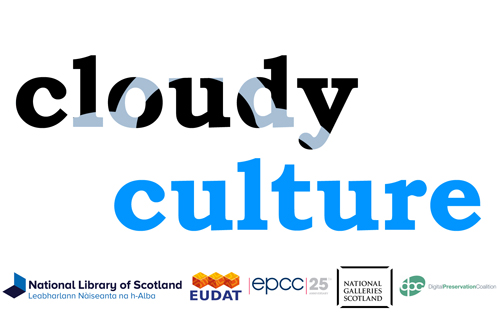
Part 4: Costs and tools
The National Library of Scotland, Edinburgh Parallel Computing Centre, National Galleries of Scotland and the Digital Preservation Coalition are working together on a project called Cloudy Culture to explore the potential of cloud services to help preserve digital culture. This is one of a number of pilots under the larger EUDAT project, funded through Horizon2020.
We’ve already published an introduction to Cloudy Culture and reports on uploading and file fixity and downloading. This final report covers the use of preservation tools in the cloud using MediaInfo as an example, and the costs of using the cloud. The costs are based on a cloud service hosted by the Edinburgh Parallel Computing Centre (EPCC) using iRODS data management software (https://irods.org). The research questions we ask are:
- Can we use arbitrary preservation tools e.g. MediaInfo, in the cloud, even when the cloud uses one operating system and the tools run on another?
- How quickly did the tool run?
- How do EPCC cloud service costs compare to local storage and Amazon Cloud costs?
DPC 2.0: Growth and Change
It’s been a real pleasure in the last few years – even in the last few weeks – to witness the way the DPC membership has grown. Some statistics underline that this is not just anecdotal but genuinely represents a step change in our organization. Let’s compare the DPC over the last 10 years:
- In 2007 the DPC offered 3 public and member events; in 2017 that was 45
- In 2007 the DPC consisted of 2 staff; it now employs 5.8fte and is looking to expand that in the coming years
- In 2007 the DPC had fewer than 28 members; in 2017 it is over 70
- In 2007 the DPC had a turnover of 178K; in 2017 that was 412K
- In 2007 the DPC was active in 3 countries; in 2017 that was 3 continents
Digital Preservation Network becomes latest member of the Digital Preservation Coalition.
Added on 8 November 2017
The Digital Preservation Coalition (DPC) is delighted to welcome the Digital Preservation Network (DPN) as its newest associate member. Based in the United States, the DPN is a membership organization focused on identifying and solving the difficult digital preservation challenges in order to make sure that the digital academic and cultural heritage content from US institutions persists for the next generation of scholars and beyond. Collectively they develop solutions that address the issues of scale, cost, workflow, and legal agreements needed for the persistence of this content.
With more than 50 members across the USA, collaborators include academic institutions, foundations, non-profits, corporations, repositories, federal and state agencies and any other organization interested or in need of long term digital preservation.
Getting Started and Making Progress training modules
Face to face training is available on request for members. This page provides access to the training resources for the Getting Started and Making Progress courses.
Getting Started with Digital Preservation
'Getting Started with Digital Preservation' introduces delegates to common digitial preservation concepts and issues before walking them through the firsts steps they can take to manage their digital assets. This includes bit-level preservation, assessing their digital preservation maturity, undertaking a risk management exercise and creating a digital asset register.
- Introduction
- Bit Preservation
- Characterisation
- Assessing Readiness
- Risk Management
- Creating a Digital Asset Register
- Next Steps
Making Progress with Digital Preservation
'Making Progress with Digital Preservation' provides delegates with guidance on the 'next steps' in developing their digital preservation capability. Presentations and exercises will cover building a business case, drafting a digital preservation policy, developing a competent digital preservation workforce and making practical preservation decisions.
- Introduction (Getting Started Re-Cap)
- Building a Business Case
- Writing a Digital Preservation Policy
- Digital Preservation Skills
- Software for Digital Preservation ( previously Open Source Software)
- Preservation Planning
Getting Started with Advocacy for Digital Preservation
This workshop provides attendees with skills and ideas for identifying stakeholders and champions required to affect change, ways to showcase digital preservation as an indispensable service for their organisation, and resources to help support their organisational advocacy activities.































































































































